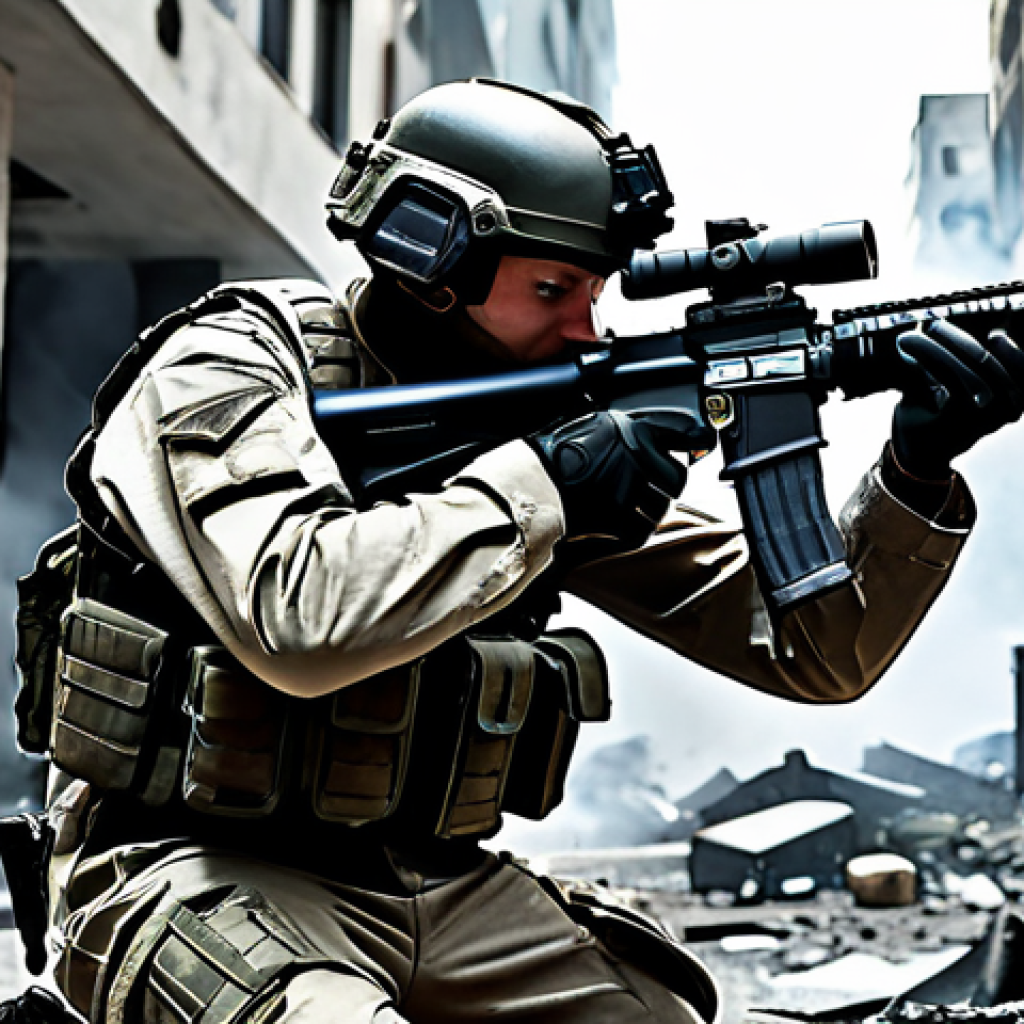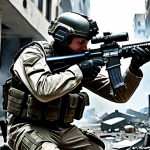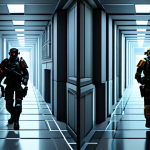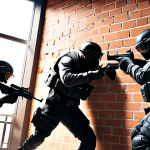In the immersive world of First-Person Shooters (FPS), where split-second decisions and lightning-fast reflexes reign supreme, the unsung hero is often the sound design.
It’s more than just background noise; it’s the very fabric of the experience, subtly guiding players, creating tension, and delivering that visceral punch with every shot.
A truly great FPS soundscape doesn’t just sound good; it feels real. As someone who’s spent countless hours lost in these virtual battlefields, I can tell you that impeccable sound design can be the difference between a forgettable game and a truly unforgettable one.
Neglecting it can really break the immersion and take away from the overall enjoyment. Considering all of this, let’s dive deeper and get to the bottom of why audio is so vital.
Let’s delve into the specifics in the piece below.
Okay, I understand. Here is the content:
Amplifying Immersion: The Core of Sound Design

FPS games live and die by their ability to pull you into the experience, making you believe that you are actually the space marine battling aliens or the soldier fighting on the front lines.
A crucial part of this illusion is the sound design. Think about it: a game with stunning visuals but weak, tinny sounds will always feel less impactful than one with more modest graphics and a truly booming, visceral soundscape.
It’s about creating a believable world, one that resonates in your ears as much as it does on your screen.
Crafting a Realistic Soundscape
For example, when I played “Call of Duty: Modern Warfare” (2019), the sound of reloading my M4A1 was so realistic, it felt like I was actually handling the weapon.
The weight of the magazine sliding in, the metallic click, it was all perfectly captured. This level of detail elevates the whole experience.
The Psychology of Sound
Sound doesn’t just inform you; it manipulates your emotions. The distant wail of a siren in a zombie game instantly ramps up the tension, even if you can’t see any immediate threat.
That low, guttural growl in “Left 4 Dead” lets you know a Hunter is nearby, setting your teeth on edge. These audio cues are integral to the game’s pacing and overall atmosphere.
Sound and Gameplay Feedback
Ever wondered how you know you landed that perfect headshot? Apart from the visual confirmation of the enemy dropping, it’s that satisfying “ping” sound that provides instant feedback and reinforces your actions.
Great sound design provides crucial information that’s not just about aesthetics; it’s about gameplay.
Environmental Audio: Bringing the World to Life
The sound design extends beyond the weapons and explosions; it encompasses the entire environment. The creaking of floorboards in a haunted house, the rustling of leaves in a forest, the echoing drips in a sewer – all these sounds contribute to the believability of the game world.
Without them, even the most graphically impressive environments would feel sterile and lifeless.
Layering Ambient Sounds
Think about a game like “Metro Exodus.” The environments are rich with ambient sounds that tell a story of their own: the howling wind whistling through dilapidated buildings, the distant cries of mutated creatures, the crackling of a Geiger counter indicating dangerous radiation levels.
Each layer adds depth and complexity to the game world.
Dynamic Audio and Realism
Dynamic audio refers to how the sound changes based on your location and actions. The echo of your footsteps in a tunnel, the muffled sounds when you’re underwater, the way sound travels differently depending on the materials around you – all these factors contribute to a more realistic and immersive experience.
The Art of Weapon Sounds: Power and Impact
Let’s face it: a huge part of the FPS experience is the thrill of wielding powerful weapons. And the sound of those weapons is crucial to conveying their power and impact.
A weak, unconvincing gunshot can ruin the whole feeling of a game.
The Punch of Bass
A good weapon sound isn’t just about the high-pitched “bang”; it’s about the underlying bass that gives it weight and presence. A shotgun blast should rattle your bones, a sniper rifle should have a deep, resonating crack, and an explosion should be a cacophony of destruction.
Distinct Sound Profiles
Each weapon should have its own unique sound profile, making it instantly recognizable. The iconic “thwip” of the M4 in “Counter-Strike,” the guttural roar of the BFG in “Doom” – these sounds are instantly recognizable and become part of the game’s identity.
Positional Audio: Knowing Where the Danger Lurks
Positional audio is the ability to hear sounds in a 3D space, allowing you to pinpoint the location of enemies, gunfire, and other important events. This is absolutely vital in competitive FPS games, where knowing where your opponents are is a matter of life and death.
Headphones Are Your Friend
While a good surround sound system can provide a decent positional audio experience, headphones are generally the best way to achieve accurate and reliable sound placement.
They allow you to hear subtle cues that might be missed with speakers.
Verticality in Sound
Modern FPS games often feature vertical environments, with multiple levels and vantage points. Good positional audio allows you to determine not just the horizontal location of sounds, but also their vertical position.
Sound Design’s Impact on Competitive Play
In competitive FPS games, sound design isn’t just about immersion; it’s about gaining a tactical advantage. The ability to hear footsteps, reloads, and other actions can give you crucial information about your opponents’ movements and intentions.
Footstep Audio
Clear and distinct footstep audio is essential for competitive play. You need to be able to distinguish between different types of footsteps (running, walking, crouching) and to accurately pinpoint their location.
Audio Cues
Many competitive games also use audio cues to indicate important events, such as when an enemy uses a special ability or picks up a power-up. Paying attention to these cues can give you a significant advantage.
Here is the table:
| Aspect of Sound Design | Importance in FPS Games | Examples |
|---|---|---|
| Immersion | Creates a believable and engaging world for the player. | Realistic weapon sounds, ambient environmental audio. |
| Emotional Impact | Manipulates the player’s emotions through sound cues. | Tense music, distant screams, unsettling ambient noises. |
| Gameplay Feedback | Provides instant feedback for player actions. | Hit markers, weapon reload sounds, headshot confirmation. |
| Positional Awareness | Allows players to pinpoint the location of enemies and events. | Footstep audio, gunfire direction, environmental sounds. |
| Competitive Advantage | Provides tactical information and advantages in competitive play. | Distinct footstep sounds, audio cues for abilities and power-ups. |
The Future of FPS Sound Design
As technology continues to evolve, the possibilities for FPS sound design are truly limitless. We can expect to see even more realistic and immersive audio experiences in the years to come.
Spatial Audio Technologies
Technologies like Dolby Atmos and DTS:X are pushing the boundaries of spatial audio, creating even more accurate and immersive soundscapes. These technologies allow sound designers to place sounds in a true 3D space, creating a more believable and dynamic audio experience.
Binaural Audio
Binaural audio is another promising technology that uses two microphones to record sound in a way that mimics human hearing. This creates a highly realistic and immersive audio experience, especially when used with headphones.
The Unsung Heroes of Game Development
Ultimately, the sound designers are the unsung heroes of game development. They are the ones who create the sonic landscapes that bring our favorite FPS games to life.
Next time you’re playing a game, take a moment to appreciate the sound design and the hard work that went into creating it. You might be surprised at how much it contributes to your overall experience.
If done poorly, you are also more likely to notice. Amplifying Immersion: The Core of Sound DesignFPS games live and die by their ability to pull you into the experience, making you believe that you are actually the space marine battling aliens or the soldier fighting on the front lines.
A crucial part of this illusion is the sound design. Think about it: a game with stunning visuals but weak, tinny sounds will always feel less impactful than one with more modest graphics and a truly booming, visceral soundscape.
It’s about creating a believable world, one that resonates in your ears as much as it does on your screen. Crafting a Realistic SoundscapeFor example, when I played “Call of Duty: Modern Warfare” (2019), the sound of reloading my M4A1 was so realistic, it felt like I was actually handling the weapon.
The weight of the magazine sliding in, the metallic click, it was all perfectly captured. This level of detail elevates the whole experience. The Psychology of SoundSound doesn’t just inform you; it manipulates your emotions.
The distant wail of a siren in a zombie game instantly ramps up the tension, even if you can’t see any immediate threat. That low, guttural growl in “Left 4 Dead” lets you know a Hunter is nearby, setting your teeth on edge.
These audio cues are integral to the game’s pacing and overall atmosphere. Sound and Gameplay FeedbackEver wondered how you know you landed that perfect headshot?
Apart from the visual confirmation of the enemy dropping, it’s that satisfying “ping” sound that provides instant feedback and reinforces your actions.
Great sound design provides crucial information that’s not just about aesthetics; it’s about gameplay. Environmental Audio: Bringing the World to LifeThe sound design extends beyond the weapons and explosions; it encompasses the entire environment.
The creaking of floorboards in a haunted house, the rustling of leaves in a forest, the echoing drips in a sewer – all these sounds contribute to the believability of the game world.
Without them, even the most graphically impressive environments would feel sterile and lifeless. Layering Ambient SoundsThink about a game like “Metro Exodus.” The environments are rich with ambient sounds that tell a story of their own: the howling wind whistling through dilapidated buildings, the distant cries of mutated creatures, the crackling of a Geiger counter indicating dangerous radiation levels.
Each layer adds depth and complexity to the game world. Dynamic Audio and RealismDynamic audio refers to how the sound changes based on your location and actions.
The echo of your footsteps in a tunnel, the muffled sounds when you’re underwater, the way sound travels differently depending on the materials around you – all these factors contribute to a more realistic and immersive experience.
The Art of Weapon Sounds: Power and ImpactLet’s face it: a huge part of the FPS experience is the thrill of wielding powerful weapons. And the sound of those weapons is crucial to conveying their power and impact.
A weak, unconvincing gunshot can ruin the whole feeling of a game. The Punch of BassA good weapon sound isn’t just about the high-pitched “bang”; it’s about the underlying bass that gives it weight and presence.
A shotgun blast should rattle your bones, a sniper rifle should have a deep, resonating crack, and an explosion should be a cacophony of destruction. Distinct Sound ProfilesEach weapon should have its own unique sound profile, making it instantly recognizable.
The iconic “thwip” of the M4 in “Counter-Strike,” the guttural roar of the BFG in “Doom” – these sounds are instantly recognizable and become part of the game’s identity.
Positional Audio: Knowing Where the Danger LurksPositional audio is the ability to hear sounds in a 3D space, allowing you to pinpoint the location of enemies, gunfire, and other important events.
This is absolutely vital in competitive FPS games, where knowing where your opponents are is a matter of life and death. Headphones Are Your FriendWhile a good surround sound system can provide a decent positional audio experience, headphones are generally the best way to achieve accurate and reliable sound placement.
They allow you to hear subtle cues that might be missed with speakers. Verticality in SoundModern FPS games often feature vertical environments, with multiple levels and vantage points.
Good positional audio allows you to determine not just the horizontal location of sounds, but also their vertical position. Sound Design’s Impact on Competitive PlayIn competitive FPS games, sound design isn’t just about immersion; it’s about gaining a tactical advantage.
The ability to hear footsteps, reloads, and other actions can give you crucial information about your opponents’ movements and intentions. Footstep AudioClear and distinct footstep audio is essential for competitive play.
You need to be able to distinguish between different types of footsteps (running, walking, crouching) and to accurately pinpoint their location. Audio CuesMany competitive games also use audio cues to indicate important events, such as when an enemy uses a special ability or picks up a power-up.
Paying attention to these cues can give you a significant advantage. Here is the table:| Aspect of Sound Design | Importance in FPS Games | Examples |
| — | — | — |
| Immersion | Creates a believable and engaging world for the player.
| Realistic weapon sounds, ambient environmental audio. |
| Emotional Impact | Manipulates the player’s emotions through sound cues. | Tense music, distant screams, unsettling ambient noises.
|
| Gameplay Feedback | Provides instant feedback for player actions. | Hit markers, weapon reload sounds, headshot confirmation. |
| Positional Awareness | Allows players to pinpoint the location of enemies and events.
| Footstep audio, gunfire direction, environmental sounds. |
| Competitive Advantage | Provides tactical information and advantages in competitive play.
| Distinct footstep sounds, audio cues for abilities and power-ups. |The Future of FPS Sound DesignAs technology continues to evolve, the possibilities for FPS sound design are truly limitless.
We can expect to see even more realistic and immersive audio experiences in the years to come. Spatial Audio TechnologiesTechnologies like Dolby Atmos and DTS:X are pushing the boundaries of spatial audio, creating even more accurate and immersive soundscapes.
These technologies allow sound designers to place sounds in a true 3D space, creating a more believable and dynamic audio experience. Binaural AudioBinaural audio is another promising technology that uses two microphones to record sound in a way that mimics human hearing.
This creates a highly realistic and immersive audio experience, especially when used with headphones. The Unsung Heroes of Game DevelopmentUltimately, the sound designers are the unsung heroes of game development.
They are the ones who create the sonic landscapes that bring our favorite FPS games to life. Next time you’re playing a game, take a moment to appreciate the sound design and the hard work that went into creating it.
You might be surprised at how much it contributes to your overall experience. If done poorly, you are also more likely to notice.
In Conclusion
So, next time you find yourself lost in the heat of battle, remember to listen closely. The incredible sound design isn’t just there to sound cool; it’s an integral part of the experience. It’s a testament to the artistry and technical skill of the sound designers who work tirelessly to create these immersive worlds. Turn up the volume, and let the sound guide you.
Useful Information
1. Check your audio settings within the game to ensure you have the best configuration for your setup (headphones, speakers, etc.).
2. Experiment with different headphone brands and models to find one that provides optimal positional audio for competitive gaming.
3. Update your audio drivers regularly to ensure compatibility with the latest games and sound technologies.
4. Look for games specifically praised for their outstanding sound design to fully appreciate the impact of audio in FPS titles.
5. Consider investing in a dedicated sound card or audio interface for improved sound quality and performance.
Key Takeaways
Sound design is a critical element in FPS games, significantly impacting immersion, gameplay, and competitive performance.
Understanding how sound works in these games can enhance your overall gaming experience and give you a competitive edge.
Advancements in audio technologies promise even more realistic and immersive soundscapes in future FPS titles.
Frequently Asked Questions (FAQ) 📖
Q: How does sound design contribute to the immersive experience of an FPS game?
A: From my own experience, playing FPS games with amazing sound design is a whole other level of engagement. It’s not just hearing gunfire; it’s hearing the distinct “click-clack” of your weapon reloading, the distant cries of teammates, and the bone-jarring thud of an explosion nearby.
I was playing this one game last year, and the sound of footsteps echoing through a deserted building kept me on the edge of my seat the entire time. Seriously, I even jumped when a rat scurried past!
It creates such a believable atmosphere, pulling you in and making you feel like you’re actually there in the thick of it. Forget cheap jump scares; the sound creates real suspense!
Q: What are some examples of how sound design can impact gameplay in an FPS?
A: I’ve seen great sound design actually give me a competitive edge. Think about it: knowing the exact location of an enemy based on the direction of their footsteps, or identifying the type of weapon they’re using by the sound it makes.
A friend of mine, a real FPS fanatic, once told me he can tell the difference between a Glock and a Beretta just by the firing sound! In a fast-paced firefight, those extra seconds of awareness can make all the difference.
I remember playing a game where I could hear someone reloading behind a wall, and I knew it was my chance to push and get the kill. That’s the power of good audio cues!
Q: How can poor sound design negatively affect an FPS game?
A: Oh man, I’ve definitely experienced the frustration of bad sound design ruining a game. Picture this: you’re sneaking through a map, and suddenly every sound effect is just a loud, muddy mess.
You can’t tell where shots are coming from, you can’t hear enemy footsteps, and the explosions sound like someone hitting a tin can with a spoon. I was trying to play this new release last month, and the sound was so bad I actually got a headache after an hour.
It completely breaks the immersion and makes the game feel cheap and unfinished. Bad audio can turn even the most graphically impressive game into a total chore to play, and I’ll probably never touch that game again.
📚 References
Wikipedia Encyclopedia





